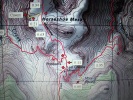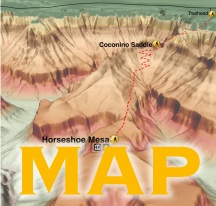| Guide | ♦ | 53 Triplogs | 2 Topics |
details | drive | permit | forecast | route |
stats |
photos | triplogs | topics | location |
| 636 | 53 | 2 |
NO PUBLIC ACCESS page removed
Grand Canyon NPS Details THE GRANDVIEW TRAIL IS DANGEROUS IN WINTER. HARD ICE OFTEN SHEATHES POTENTIALLY HAZARDOUS PASSAGES MAKING SOME SORT OF TRACTION DEVICE (I.E. INSTEP CRAMPONS) MANDATORY. Use extra caution around mines. The rim of the open pits is often unstable. Rotting support timbers in the tunnels pose an obvious hazard. The many artifacts scattered about are protected by federal law. Enjoy what you find but leave it as found. Permits are required to enter caves in Grand Canyon National Park due to the extremely sensitive nature of cultural and natural resources inside. Contact the Backcountry Information Center for further information. |
 Route Editor
Route Editor







